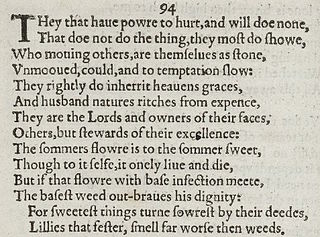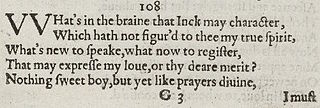
Sonnet 94 is one of 154 sonnets written by the English playwright and poet William Shakespeare. It is a member of the Fair Youth sequence, in which the poet expresses his love towards a young man.
Sonnet 132 is one of 154 sonnets written by the English playwright and poet William Shakespeare.
Sonnet 149 is one of 154 sonnets written by the English playwright and poet William Shakespeare.

Sonnet 139 is one of 154 sonnets written by the English playwright and poet William Shakespeare.

Sonnet 133 is a poem in sonnet form written by William Shakespeare, first published in 1609 in Shakespeare's sonnets.

Sonnet 131 is a sonnet written by William Shakespeare and was first published in a 1609 quarto edition titled Shakespeare's sonnets. It is a part of the Dark Lady sequence, which are addressed to an unknown woman usually assumed to possess a dark complexion.

Sonnet 75 is one of 154 sonnets written by the English playwright and poet William Shakespeare. It is a member of the Fair Youth sequence, in which the poet expresses his love towards a young man.

Sonnet 119 is one of 154 sonnets written by the English playwright and poet William Shakespeare. It's a member of the Fair Youth sequence, in which the poet expresses his love towards a young man.

Sonnet 80 is one of 154 sonnets published by the English playwright and poet William Shakespeare in 1609. It is part of the Fair Youth sequence, and the third sonnet of the Rival Poet sequence.

Sonnet 82 is one of 154 sonnets published by William Shakespeare in a quarto titled Shakespeare's Sonnets in 1609. It is a part of the Fair Youth series of sonnets, and the fifth sonnet of the Rival Poet group.

Sonnet 83 is one of 154 sonnets published by William Shakespeare in a quarto titled Shakespeare's Sonnets in 1609. It is a part of the Fair Youth group of sonnets, and the sixth sonnet of the Rival Poet group.

Sonnet 84 is one of 154 sonnets published by the English playwright and poet William Shakespeare in 1609. It's part of the Fair Youth sequence, and the seventh sonnet of the Rival Poet group.

Sonnet 90 is one of 154 sonnets written by the English playwright and poet William Shakespeare. It is a member of the Fair Youth sequence, in which the poet expresses his love towards a young man.

Sonnet 95 is one of 154 sonnets written by the English playwright and poet William Shakespeare. It is a member of the Fair Youth sequence, in which the poet expresses his love towards a young man.

Sonnet 104 is one of 154 sonnets written by the English playwright and poet William Shakespeare. It is a member of the Fair Youth sequence, in which the poet expresses his love towards a young man.

Sonnet 108 is one of 154 sonnets written by the English playwright and poet William Shakespeare. It is a member of the Fair Youth sequence, in which the poet expresses his love towards a young man.

Sonnet 111 is one of 154 sonnets written by the English playwright and poet William Shakespeare. It is a member of the Fair Youth sequence, in which the poet expresses his love towards a young man.

Sonnet 112 is one of 154 sonnets written by the English playwright and poet William Shakespeare. It is a member of the Fair Youth sequence, in which the poet expresses his love towards a young man. It is noted for its compressed and obscure language.
Sonnet 113 is one of 154 sonnets written by the English playwright and poet William Shakespeare. It's a member of the Fair Youth sequence, in which the poet expresses his love towards a young man.

Sonnet 115 is one of 154 sonnets written by the English playwright and poet William Shakespeare. It is a member of the Fair Youth sequence, in which the poet expresses his love towards a young man.






















